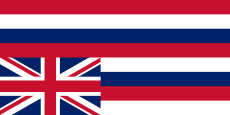
Back حركة سيادة هاواي Arabic Moviment Hawaià de la Sobirania Catalan Mudiad annibyniaeth Hawai'i Welsh Hawaiische Unabhängigkeitsbewegung German Movimiento Hawaiano de la Soberanía Spanish Havaijin itsenäisyysliike Finnish Mouvement pour la souveraineté hawaïenne French Movemento pola soberanía hawaiana Galician ハワイ独立運動 Japanese 하와이 주권운동 Korean
| Part of a series on the |
| Hawaiian sovereignty movement |
|---|
 |
| Main issues |
| Governments |
| Historical conflicts |
| Modern events |
| Parties and organizations |
| Documents and ideas |
| Books |
The Hawaiian sovereignty movement (Hawaiian: ke ea Hawaiʻi) is a grassroots political and cultural campaign to reestablish an autonomous or independent nation or kingdom of Hawaii out of a desire for sovereignty, self-determination, and self-governance.[2][3]
Some groups also advocate some form of redress from the United States for its 1893 overthrow of Queen Liliʻuokalani, and for what is described as a prolonged military occupation beginning with the 1898 annexation. The movement generally views both the overthrow and annexation as illegal.[4][5]
Palmyra Atoll and Sikaiana were annexed by the Kingdom in the 1860s, and the movement regards them as under illegal occupation along with the Hawaiian Islands.[6][7]
The Apology Resolution the United States Congress passed in 1993 acknowledged that the overthrow of the Hawaiian Kingdom was an illegal act.[8]
Sovereignty advocates have attributed problems plaguing native communities including homelessness, poverty, economic marginalization, and the erosion of native traditions to the lack of native governance and political self-determination.[9][10]
The forced depopulation of Kaho'olawe and its subsequent bombing, the construction of the Mauna Kea Observatories, and the Red Hill water crisis caused by the US Navy's mismanagement are some of the contemporary matters relevant to the sovereignty movement.
It has pursued its agenda through educational initiatives and legislative actions. Along with protests throughout the islands, at the capital (Honolulu) itself and other locations sacred to Hawaiian culture, sovereignty activists have challenged U.S. forces and law.[11]
- ^ Spencer, Thomas P. (1895). Kaua Kuloko 1895. Honolulu: Papapai Mahu Press Publishing Company. OCLC 19662315.
- ^ Michael Kioni Dudley; Keoni Kealoha Agard (January 1993). A call for Hawaiian sovereignty. Nā Kāne O Ka Malo Press. p. 167. ISBN 978-1-878751-09-6.
- ^ "Kanahele group pushes plan for sovereign nation". hawaii-nation.org. Archived from the original on March 9, 2016. Retrieved November 13, 2016.
- ^ "The Rape of Paradise: The Second Century Hawai'ians Grope Toward Sovereignty As The U.S. President Apologizes" Archived March 3, 2016, at the Wayback Machine, Perceptions Magazine, March/April 1996, p. 18–25
- ^ Grass, Michael (August 12, 2014). "As Feds Hold Hearings, Native Hawaiians Press Sovereignty Claims". Government Executive. Government Executive. Archived from the original on October 7, 2015. Retrieved October 29, 2015.
- ^ "U.S. Purchase of Palmyra Hits Impasse". Pacific Islands Report. February 10, 2000. Archived from the original on January 31, 2018. Retrieved January 30, 2018.
- ^ Trask, Haunani-Kay (April 2, 2010). "The Struggle For Hawaiian Sovereignty – Introduction". Cultural Survival. Archived from the original on January 31, 2018. Retrieved January 30, 2018.
- ^ "Public Law 103-150" (PDF). gpo.gov. November 23, 1993. Archived (PDF) from the original on April 7, 2018. Retrieved July 3, 2018.
- ^ "Historic election could return sovereignty to Native Hawaiians". Archived from the original on October 7, 2016. Retrieved November 13, 2016.
- ^ Trask, Haunani-Kay (April 2, 2010). "The Struggle For Hawaiian Sovereignty – Introduction". Cultural Survival. Archived from the original on October 19, 2016. Retrieved November 13, 2016.
- ^ Podgers, James (June 1997). "Greetings from independent Hawaii". ABA Journal. American Bar Association. pp. 75–76. ISSN 0747-0088. Archived from the original on July 2, 2019. Retrieved March 19, 2016.